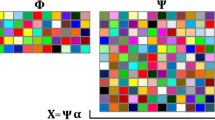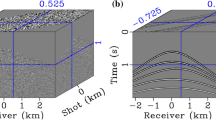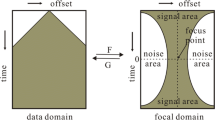Abstract
Marchenko-based method is a novel multiple-free imaging approach for a target subsurface area. High-density acquisition can help obtain an accurate Marchenko imaging, but will significantly increase the acquisition cost. Obtaining accurate Marchenko imaging while maintaining low acquisition cost is therefore an important practical hurdle to overcome. I develop a compressive sensing-based low-cost acquisition design relying on a sparse and random irregular survey to meet the needs of the Marchenko imaging. I examine the influence of noise on Marchenko imaging, and demonstrate that reconstructing seismic data from noisy observations by using compressive sensing has a natural de-noising effect, and yield comparable Green’s functions and resultant high-quality angle gathers and Marchenko imaging. Numerical tests using a 2D model show that as few as 30% of receivers are needed when compressive-sensing reconstruction is combined with Marchenko method.

















Similar content being viewed by others
References
Abma, R., & Kabir, N. (2006). 3D interpolation of irregular data with a pocs algorithm. Geophysics, 71(6), 91–97.
Baraniuk, R. G., & Kelly, K. (2007). Compressive sensing. Signal Processing, 4, 12–21.
Beck, A., & Teboulle, M. (2009). A fast iterative shrinkage-thresholding algorithm for linear inverse problems. Society for Industrial and Applied Mathematics, 2(1), 75–90.
Behura, J., Wapenaar, K., & Snieder, R. (2014). Autofocus imaging: Image reconstruction based on inverse scattering theory. Geophysics, 79(3), 19–26.
Broggini, F., Wapenaar, K., van der Neut, J., & Snieder, R. (2012). Data-driven green’s function retrieval and application to imaging with multidimensional deconvolution. Journal of Geophysical Research: Solid Earth, 119(1), 425–441.
Brown, L., Mosher, C. C., Li, C., Olson, R., Doherty, J., Carey, T. C., et al. (2017). Application of compressive seismic imaging at lookout field, alaska. The Leading Edge, 36(8), 670–676.
Candes, E., & Romberg, J. (2005). l1-magic: Recovery of sparse signals via convex programming (pp. 1–19).
Candes, M. B. W., & Boyd, S. P. (2008). Enhancing sparsity by reweighted l1 minimization. Journal of Fourier Analaysis and Applications, 14, 877–905.
Candes, E. J., Romberg, J., & Tao, T. (2006). Robust uncertainty principles: Exact signal reconstruction from highly incomplete frequency information. IEEE Transactions on Information Theory, 52(2), 489–509.
Candes, E. J., & Tao, T. (2006). Near-optimal signal recovery from random projections: Universal encoding strategies? IEEE Transactions on Information Theory, 52(12), 5406–5425.
Candes, E. J., & Wakin, M. B. (2008). An introduction to compressive sampling. IEEE Signal Processing Magazine, 25(2), 21–30.
Chen, Y., Keling Chen, P. S., & Wang, Y. (2014). Irregular seismic data reconstruction using a percentile-half-thresholding algorithm. Journal of Geophysics and Engineering, 11(6), 34–46.
Daubechies, I., Defrise, M., & De Mol, C. (2004). An iterative thresholding algorithm for linear inverse problems with a sparsity constraint. Communications on Pure and Applied Mathematics, 57(11), 1413–1457.
Donoho, D. L. (2001). Uncertainty principles and ideal atomic decomposition. IEEE Transactions on Information Theory, 47, 2845–2862.
Donoho, D. L. (2006). Compressed sensing. IEEE Transactions on Information Theory, 52(4), 1289–1306.
Haindl, C.M., Broggini, F., Ravasi, M., & Manen, D.-J. (2018) Using sparsity to improve the accuracy of marchenko imaging of single and time-lapse seismic given imperfect acquisitiont (pp. 1–5).
Herrmann, F. J. (2010). Randomized sampling and sparsity: Getting more information from fewer samples. Geophysics, 75(6), 173–187.
Herrmann, F. J., Erlangga, Y. A., & Lin, T. T. (2009). Compressive simultaneous full-waveform simulation. Geophysics, 74(4), 35–40.
Jia, X., Guitton, A., & Snieder, R. (2018). A practical implementation of subsalt marchenko imaging with a gulf of mexico data set. Geophysics, 83(5), 409–419.
Jia, X., Zhao, Y., & Snieder, R. (2019). Data interpolation for 3d marchenko green’s function retrieval (pp. 4725–4729).
Li, C., Mosher, C. C., Shan, S., & Brewer, J. D. (2013). Marine towed streamer data reconstruction based on compressive sensing (pp. 3597–3602).
Li, X., Aravkin, A. Y., van Leeuwen, T., & Herrmann, F. J. (2012). Fast randomized full-waveform inversion with compressive sensing. Geophysics, 77(3), 13–17.
Lomas, A., & Curtis, A. (2019). An introduction to marchenko methods for imaging. Geophysics, 84(2), 35–45.
Lustig, M., Donoho, D., & Pauly, J. M. (2007). Sparse mri: The application of compressed sensing for rapid mr imaging. Magnetic Resonance in Medicine, 58(6), 1182–1195.
Marchenko, V. A. (1955). On reconstruction of the potential energy from phases of the scattered waves. Doklady Akademii Nauk SSSR, 5(104), 695–698.
Meles, G. A., Löer, K., Ravasi, M., Curtis, A., & da Costa Filho, C. A. (2015). Internal multiple prediction and removal using marchenko autofocusing and seismic interferometry. Geophysics, 80(1), 7–11.
Mosher, C. C., Keskula, E., Kaplan, S. T., Keys, R. G., Li, C., Ata, E. Z., Morley, L. C., Brewer, J. D., Janiszewski, F. D., Eick, P. M., Olson, R. A., & Sood, S. (2012). Compressive seismic imaging (pp. 1–5).
Mosher, C., Li, C., Williams, L., Carey, T., Olson, R., Malloy, J., & Ji, Y. (2017). Compressive seismic imaging: Land vibroseis operations in Alaska (pp. 127–131).
Neelamani, R., Krohn, C. E., Krebs, J. R., Deffenbaugh, M., Anderson, J. E., & Romberg, J. K. (2008). Efficient seismic forward modeling using simultaneous random sources and sparsity (pp. 2107–2111).
Peng, H., & Vasconcelos, I. (2019) A study of acquisition-related sub-sampling and aperture effects on marchenko focusing and redatuming (pp. 248–252).
Peng, Y. S., Vasconcelos, I., & Zhang, L. (2019). On the effects of acquisition sampling on marchenko-based focusing and primary estimation, (pp. 1–5).
Pilikos, G., & Faul, A. C. (2017). Bayesian feature learning for seismic compressive sensing and denoising. Geophysics, 82(6), 91–104.
Ravasi, M. (2017). Rayleigh-marchenko redatuming for target-oriented, true-amplitude imaging. Geophysics, 82(6), 439–452.
Ravasi, M. (2019). Vasconcelos: Pylops–A linear-operator python library for large scale optimization. Software X
Ronen, J. (1987). Wave-equation trace interpolation. Geophysics, 52(7), 973–984.
Rose, J. H. (2001). single-sided focusing of the time-dependent schrödinger equation. Physical Review A, 65, 012707.
Rudin, A. E. F., & Osher, S. (1992). Nonlinear total variation noise removal algorithm. Physica D, 60, 25968.
Spitz, S. (1991). Seismic trace interpolation in the f-x domain. Geophysics, 56(6), 785–794.
Staring, K. M. (2020). Wapenaar: Three-dimensional marchenko internal multiple attenuation on narrow azimuth streamer data of the santos basin, brazil. Geophysics Prospect, 68(6), 1864–1877.
Tropp, J. A., Laska, J. N., Duarte, M. F., Romberg, J. K., & Baraniuk, R. G. (2010). Beyond Nyquist: Efficient sampling of sparse bandlimited signals. IEEE Transactions on Information Theory, 56(1), 520–544.
van der Neut, I.V. J., & Wapenaar, K. (2015). On Green’s function retrieval by iterative substitution of the coupled Marchenko equations (Chap. 203, pp. 792–813).
Wakin, M., Becker, S., Nakamura, E., Grant, M., Sovero, E., Ching, D., et al. (2012). A nonuniform sampler for wideband spectrally-sparse environments. IEEE Journal on Emerging and Selected Topics in Circuits and Systems, 2(3), 516–529.
Wakin, M. B., Laska, J. N., Duarte, M. F., Baron, D., Sarvotham, S., Takhar, D., Kelly, K. F., & Baraniuk, R. G. (2006). An architecture for compressive imaging. In: 2006 International Conference on Image Processing (pp. 1273–1276).
Wapenaar, K. (2014). Single-sided marchenko focusing of compressional and shear waves. Physical Review E, 90, 063202.
Wapenaar, K., Thorbecke, J., van der Neut, J., Broggini, F., Slob, E., & Snieder, R. (2014). Marchenko imaging. Geophysics, 79(3), 39–57.
Wapenaar, K., & van Ijsseldijk, J. (2020). Discrete representations for marchenko imaging of imperfectly sampled data. Geophysics, 85(2), 1–5.
Wason, H., & Herrmann, F.J. (2013). Time-jittered ocean bottom seismic acquisition (pp. 1–6).
Zhang, M. (2021). Time-lapse seismic data reconstruction using compressive sensing. Geophysics, 86(5), 37–48.
Zhang, M., & Lumley, D. (2019). Reconstruction of 3D seismic data from sparse random OBN acquisition by compressive sensing (pp. 127–130).
Acknowledgements
I would like to thank the Department of Geosciences at UT Dallas and the SEG Earl D. and Reba C. Griffin Memorial Scholarship for the financial support. I also thank Matteo Ravasi and Claudia Haindl for kindly providing the 2D Marchenko imaging algorithm.
Author information
Authors and Affiliations
Corresponding author
Ethics declarations
Conflict of interest
The authors have no relevant financial or non-financial interests to disclose. The authors have no conflicts of interest to declare that are relevant to the content of this article.
Additional information
Publisher's Note
Springer Nature remains neutral with regard to jurisdictional claims in published maps and institutional affiliations.
Appendices
Appendix A: Total Variation (TV)
Given a 2D image represented by x with the size of \(n*n\), let \(x_{ij}\) denote the value in ith row and jth column of the x. Let us define the operators
and
where \(D_{ij}x\) can be interpreted as discrete gradient vector of x.
The total variation (Rudin and Osher, 1992) of x is simply the sum of the magnitudes of this discrete gradient at every location i, j of x:
Appendix B: Fast Iterative Shrinkage-Thresholding Algorithm (FISTA)
I applied FISTA with backtracking proposed by (Beck and Teboulle, 2009) in my paper,
Step 0. Take \(L_{0} > 0\), some \(\eta > 1\), and \(x_{0} \in {\mathbb {R}}^{n}\). Set \(y_{1} = x_{0}\), \(t_{1}=1\).
Step k. (\(k \geqslant 1\)) Find the smallest nonnegative integers \(i_{k}\) such that with \({\bar{L}} = \eta ^{i_{k}}L_{k-1}\)
Set \(L_{k} = \eta ^{i_{k}}L_{k-1}\) and compute
For more details on ISTA and FISTA, I refer readers to these original publications (Beck & Teboulle, 2009; Daubechies et al., 2004).
Rights and permissions
About this article
Cite this article
Zhang, M. Compressive Sensing Acquisition with Application to Marchenko Imaging. Pure Appl. Geophys. 179, 2383–2404 (2022). https://doi.org/10.1007/s00024-022-03029-5
Received:
Revised:
Accepted:
Published:
Issue Date:
DOI: https://doi.org/10.1007/s00024-022-03029-5




